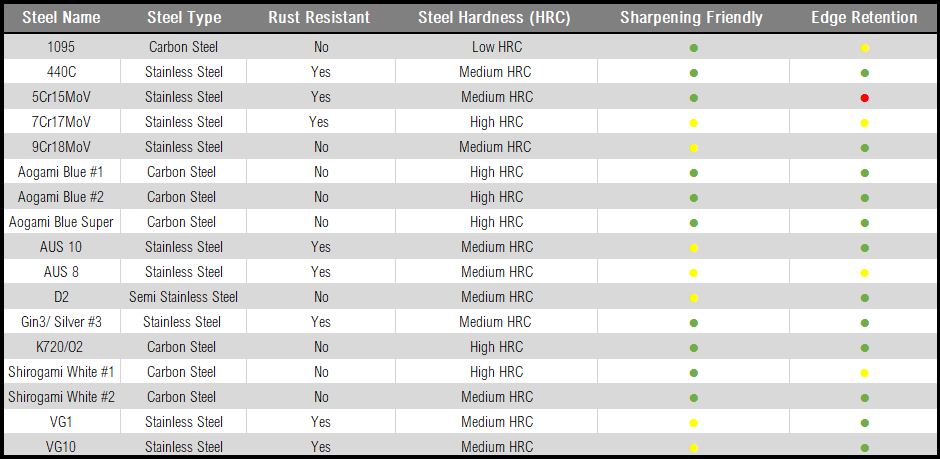Discover the top knife steel types for your needs. Learn about the different properties and characteristics of each steel type to choose the best one for your knife.

Steel Type
Carbon Steel
Carbon steel knives are a preferred choice for many advanced cooking enthusiasts, renowned for their remarkable ability to achieve a sharp edge and easy sharpening. Carbon steel, distinguished by a higher carbon percentage and less chrome, vanadium, and molybdenum compared to stainless steel, imparts distinctive properties.
The elevated carbon content enables the blade to attain a finer edge, resulting in superior cutting performance. However, this advantage comes with a tradeoff, as they may be more susceptible to rust and corrosion without proper care.
A notable characteristic of carbon steel knives is the development of a patina over time—a natural, dark coating formed on the blade through its reaction with air and moisture. While some appreciate the patina for its character, uniqueness, and improved food release, others may find its appearance bothersome.
In summary, carbon steel knives are a popular choice for those seeking unparalleled sharpness. Despite requiring a bit more care than stainless steel knives, they offer unique benefits that appeal to both professional chefs and home cooks.
Stainless Steel
Stainless steel knives dominate the kitchen knife scene, prized for their corrosion-resistant properties and durability. Stainless steel, containing a minimum of 10.5% chromium, resists rust and corrosion—ideal for humid environments or cutting acidic foods that might discolor their carbon steel counterparts.
Another notable advantage of stainless steel knives is their durability. They are generally less prone to chipping or breaking than other knife types, potentially extending their lifespan with proper care.
Maintaining stainless steel knives is also relatively straightforward. They demand less attention than other types, such as carbon steel knives, and can be easily cleaned with mild soap and water. Moreover, some models are dishwasher-safe, catering to those with time constraints who prefer not to hand wash their knives.
One potential drawback of stainless steel knives is that they may not sharpen as effectively as carbon steel. However, this can vary based on the specific grade of stainless steel and the blade's design, with some modern variants outperforming traditional carbon steel counterparts.
Rust Resistant
Yes it will require less maintenance and if you forget to wipe down your blade, aside from perhaps the rare surface rust, it will not rust the actual metal.
No prone to build rust if not dried and maintained. For those, it's highly recommended to even oil the blades to disperse humidity when they are not used regularly or stored away.
Steel Hardness (HRC)
Steel hardness is often achieved by the heat threat and can vary for many for the same steel type, the below chart is a +/- estimate of the Hardness Rockwell C.
Low HRC: Under 55
Medium HRC: Between 55 and 60
High HRC: Above 60
Sharpening Friendly
Sharpening steel can be complex discussion, below we tried to simplify the friendliness of sharpening by creating 3 general buckets for an easier comprehension.
Red is difficult to sharpen and achieve a good burr. While it's not impossible, it might take more time and effort.
Yellow is challenging for beginners to properly sharpen however with a bit of practice you can master the process.
Green is easy to create a burr in a shorter amount of time with minimal pressure.

